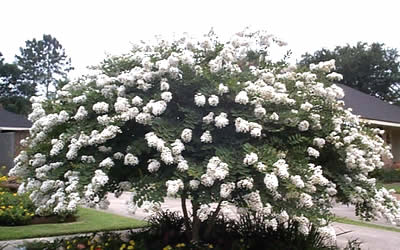
tel: 512-280-1192 Friday, June 28 2013
Nursery notes: 50% OFF all antique and knock-out roses! Anti-
ques reg. $19.99 2 gal., knock-outs reg. $24.99 2 gal. / 25% off all
yuccas, agaves & palms including windmill, Mediterranean, sabal
(Texas Native), date, pindo & sage - prices from 1 gal. $14.99, 5 gal.
from $34.99 - $69.99, 15 gal. $124.99.
New shipments of colorful, blooming perennials including Pride of
Barbados (1 gal. $7.99, 2 gal. $12.99, 5 gal. $24.99), yellow bells
(1 gal. $7.99, 2 gal. $12.99), and plumbago (1 gal. $7.99, 2 gal.
$12.99). New shipment of ghost peppers $3.99 4" pot. / New ship-
ment of groovy tie-dye bandannas $9.99. and tank tops $19.99.
[Fall Tomato Growers Success Seminar 1 p.m. July 14]

Cardamom Ginger -on sale this weekend for $9.99 (reg. $12.99).
It's the world's third most expensive spice, after saffron and vanilla.
They prefer shade or dappled sun all day, and protection from frosts.
A lot of gardeners keep them in pots. (photo: Julie Blake)
_____________________________________________________
Building nests: From New Age cocoons and backyard playthings
of the rich to public installations made from the wood of hurricane-
felled trees... human nests are having a bit of a moment, writes
Penelope Green in the New York Times: twigitecture
______________________________________________________
From 'Thyme to Table: LOTS of organic tomatoes $2.50/lb. and
peppers $1.50/lb 9 a.m to noon, Saturday. Look for gazpacho recipe
from Mick Vann in next week's newsletter.
_______________________________________________________
Central Texas Gardener KLRU TV. A chat with Sharon Lovejoy,
author of My First Bird Book, with lots of hands-on projects to
connect children to the world of birds; on tour, visit the Bulverde
Library butterfly garden created by the Comal master gardeners. Sat.
noon, 4 p.m. or Sun. at 9 a.m. www.klru /
_______________________________________________________

Acoma, the wondrous, weeping white crape myrtle
Crape Myrtle Monarchs
by Chris Winslow
As we toil through our summer days in lands declared by the U.S.
Department of Agriculture as ‘abnormally dry,’ sometimes it’s hard
to be cheerful. (This afternoon I hear it's going to hit 106 degrees!)
But there are plenty of plants on hand to help to lift our spirits – espe-
cially the ones that seem to flourish in the heat of this summer. Of
these, a favorite is the crape myrtle.
They bloom for months on end, and they come in any size you could
imagine. Once established they can hold up with our native tree species
during even the most prolonged droughts. Vibrant color and water
conservation rolled together into one beautiful tree.
But let’s be more specific, and choose some myrtle monarchs. I hereby
nominate, as ‘King of the Crapes’… Muskogee. This stately specimen
grows to a height of 25 to 30 feet, and blooms for four months. This
is a record-setting bloom time!
Muskogee is a light-lavender with strong resistance to powdery mildew.
Its fall leaf color is red and yellow and in winter its bark is grey and
pinkish-brown..
As ‘Queen of the Crapes,’ I nominate Natchez. This white flowering
beauty grows from 25 to 30 feet and has the second longest bloom
period of 110 days.
Her fall leaf color is red-orange and her winter bark color is cream-
cinnamon brown. Natchez is resistant to diseases, and is considered
the benchmark that all other varieties are compared to.
Besides this king and queen, there are dozens of other top performers
to choose from. For a dwarf tree, one of the best is Victor. This dark
red variety grows to 4 to 5 feet and blooms for 85 days.
For mid-size trees, those growing from 8 to 12 feet there is Siren Red,
Pink Velour, Catawba (purple), and Acoma (weeping white).
For trees between 15 and 20 feet there is Dynamite ( deep red), Red
Rocket ( red), and Tuscarora ( coral red to dark pink).
And for truly shade size trees, 25 feet and up, along with Muskogee,
Natchez – there’s Basham’s Party Pink.
The crape myrtle (Lagerstroemia indica) has been in the South since
they were first introduced from Asia in 1747. Since that time, hun-
dreds of colors and heights have been bred.
In the mid 50s, the Japanese crape myrtle (Lagerstroemia faueri)
arrived over here, and an extensive breeding program began. Horti-
culturalists began to mix the color variations of the Asian crape
myrtle with the disease resistance of the Japanese varieties.
The Japanese crapes also had trunk color attributes and greater cold
tolerance. They could now be planted farther north.
As these amazing plants go through their amazing bloom cycle, we
should all give thanks for the bright colors they bring to our land-
scapes during these harsh summer months.
Happy gardening everyone!
 Visit the website: www.itsaboutthyme.com
Visit the website: www.itsaboutthyme.com Visit the nursery:11726 Manchaca Road, Austin, 78748